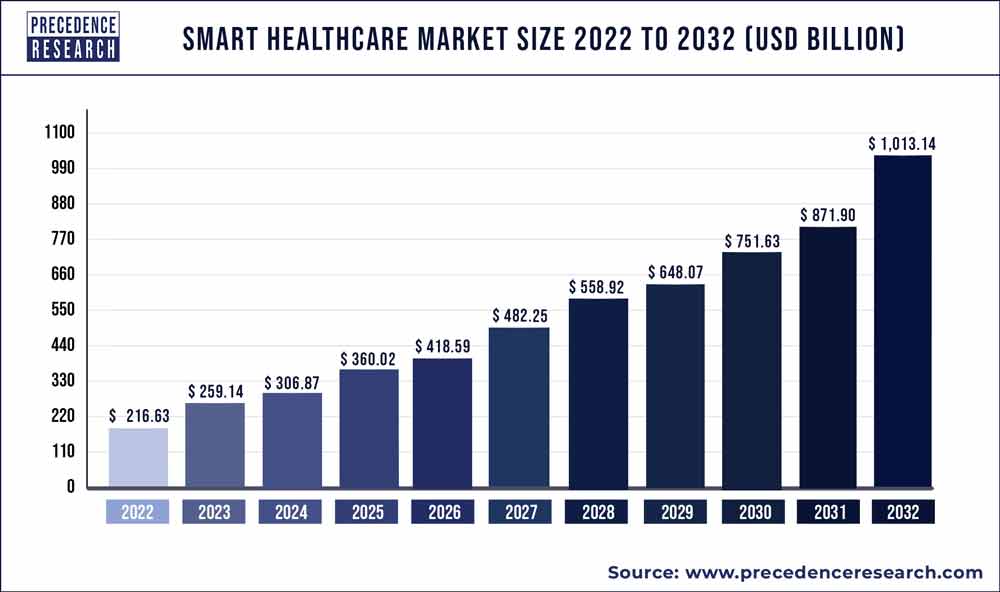
Smart healthcare is a delivery system that leverages wearable devices, the internet of things, and mobile internet to dynamically access information, connect people, materials, and institutions in the healthcare industry, and then intelligently controls and responds to medical ecosystem demands. Smart healthcare can foster interaction among all stakeholders in the healthcare industry, ensuring that participants receive the services they require, assisting parties in making informed decisions, and facilitating resource allocation. In a nutshell, smart healthcare is a higher level of medical information architecture.
The integration of digital technologies into conventional healthcare systems describes Smart Healthcare, which in turn turns it into smart healthcare. Smart healthcare increases the quality of healthcare facilities and enhances the experience of the patient. The primary purpose is to help inform users about their medical status and to keep them informed and updated about their health conditions. Various smart healthcare devices, including smart wearables, smart syringes, smart pills, and smart RFID cabinets, and many others that contribute to improving the lifestyle of the consumer, are readily available on the market. These devices help to remotely track the health conditions of patients and also help reduce the treatment cost for consumers.
Get the Sample Pages of the Report @ https://www.precedenceresearch.com/sample/1173
Scope of the Smart Healthcare Market
| Report Highlights | Details |
| Market Size in 2023 | USD 259.14 Billion |
| Market Size by 2032 | USD 1,013.14 Billion |
| Growth Rate from 2023 to 2032 | CAGR of 16.36% |
| Largest Market | North America |
| Fastest Growing Market | Asia Pacific |
| Base Year | 2022 |
| Forecast Period | 2023 to 2032 |
| Segments Covered | Product Type, Region Type |
Drivers
- Rising trends of remote patient monitoring (RPM)
- The connection between telehealth and RPM
- RPM for minorities
- RPM Management
- Increasing adoption of telemedicine due to COVID-19
Restraints
- Cyber security issues for remote patient monitoring (RPM) and telehealth
Opportunity
- Opportunities app-based personal emergency response systems (PERS)
Growth Factors
The demand for smart health systems is likely to be accentuated by growing adoption of mHealth, government digitization initiatives for healthcare, and the prevalence of chronic disorders. The healthcare sector has been changed by digitalization. In recent years, the adoption of mHealth has increased significantly, largely due to the growing use of smartphones and digitization. In 2019, according to a United Healthcare Customer Opinion Report, approximately 37% of Americans rely on the internet or mobile apps for health-related consultations.
It is expected that growing participation by players in the industry would further drive market growth. In April 2020, for example, Phillip launched a new application for the acuity-based scoring tools of eCare Manager to scrutinize patient conditions to detect worsening or any adverse COVID-19 related patterns. Likewise, Teladoc Health released Teladoc medical professionals in October 2019 for patients suffering from challenging mental and physical health conditions. This is meant to seamlessly combine specialized medical services and doctors with their patients. During the forecast period, such developments are expected to drive the market.
Role of telemedicine
The field of mental health has been transformed through telemedicine, particularly during the COVID-19 pandemic. Because mental health is such a complex process combining behavioral health and getting over stigma so that patients are comfortable with therapy, it’s become critical to have a middle ground with all the safeguards throughout these trying times. Psychiatrists and therapists can now treat patients regardless of their location because of telemedicine.
Report Highlights
- North America smart healthcare market is expected to dominate the market with the share of 33.57% in 2020 and expected to hit 31.72% by 2027.
- Europe followed by North America lead the global smart healthcare market. The Europe market is mainly characterized by the rapid commercialization of innovative technologies. Quick adoption of the latest medical technologies in the mainstream is also a key feature of the European healthcare industry.
- Asia Pacific region is expected to held market with the share of 23.53% in 2020 and predicted to reach 25.54% by 2027.
- Over the forecast period, Asia Pacific is expected to exhibit profitable growth. Due to their developed healthcare IT infrastructure and growing investments in smart healthcare, countries such as Japan, Australia and India exhibit significant potential.
- Telemedicine, due to its vast application base in different aspects of the global healthcare system occupies the largest revenue share and shall be continuing to dominate the global market. It shall also be the fastest progressing segment through the forecast period at a CAGR of 25.42%.
- At a CAGR of 22.1% from 2020 to 2027, the RFID kanban system is the fastest-growing segment.
- The second fastest-growing market segment for smart healthcare was telemedicine.
Regional Snapshots
At a revenue share of 33.57% in 2020, North America dominated the market. This is attributed to supportive government policies for digital health deployment and accessibility of highly digital literacy infrastructure. In addition, the presence of key market participants, increasing awareness of connected healthcare, high internet penetration, and smartphones, together with the use of health-related apps, are some of the key factors responsible for market growth. Over the forecast era, Asia Pacific is expected to exhibit profitable growth. Due to their existing healthcare IT infrastructure and increasing investments in smart healthcare, countries such as Japan, Australia and India exhibit significant potential. In developing nations such as China and India, the number of government digitalization initiatives is expected to accelerate the adoption of digital healthcare solutions such as health services.
The American Hospital Association (AMA) announced on March 10, 2020 that, due to its affordability and high health care value, approximately 76 percent of hospitals in the U.S. use telehealth to communicate with consulting professionals and patients. In addition, the successful adoption of e-prescription systems and electronic health records (EHR) in different healthcare centres is driving regional market development. In addition, in the March 2020, NHS U.K. to decrease the COVID-19 distribution, first-tier medical institutions were encouraged to use telemedicine U.K. at primary care hospitals, as of now. Nearly 340 million annual medical consultation documents are reported and just 1 percent of them are made via video calls. The NHS, however, plans to introduce telemedicine facilities by reducing face-to-face appointment by reducing.
Key Players & Strategies
The Smart Healthcare industry is highly opportunistic and competitive in nature because of significant advancements and developments in the product to cater the ever-changing consumer demand. In order to gain further penetration, players have pursued numerous strategic strategies such as mergers and acquisitions, product releases and alliances and collaborations. For example, in April 2020, by launching the COVID-19 High-Performance Computing Consortium in partnership with the US, IBM released AI-powered technologies to support science and health community to accelerate the discovery of medical insights and treatments for COVID-19 Agency of Science and Engineering for the Department of Energy and the White House.
Read Also: Disposable Syringes Market Size Hit US$ 12.59 Bn by 2032
Some of the prominent players in the Smart Healthcare market include:
- Allscripts
- Logi-Tag Systems
- Cerner Corporation
- SAMSUNG
- Cisco Systems
- GENERAL ELECTRIC COMPANY
- Siemens Healthcare Private Limited
- IBM Corporation
- BD
- AirStrip
- Terumo Corporation
- eClinicalWorksResideo Technologies, Inc.
- STANLEY Healthcare
- Medtronic
Segments Covered in the Report
By Product Type
- RFID Kanban Systems
- RFID Smart Cabinets
- Electronic Health Records (EHR)
- Telemedicine
- mHealth
- Smart Pills
- Smart Syringes
By Regional Outlook
North America
- US.
- Canada
Europe
- UK.
- Germany
- France
Asia Pacific
- China
- India
- Japan
- South Korea
- Rest of the World
Contact Us:
Mr. Alex
Sales Manager
Call: +1 9197 992 333
Email: sales@precedenceresearch.com
Web: https://www.precedenceresearch.com
Blog: https://www.expresswebwire.com/
Blog: https://www.uswebwire.com/
- Esoteric Testing Market Size to Hit USD 75.54 Bn by 2032 - July 17, 2024
- mRNA Therapeutics Market Size to Surpass USD 39.99 Bn By 2033 - July 17, 2024
- Acne Treatment Market Size to Hit USD 15.86 Bn by 2033 - July 17, 2024

